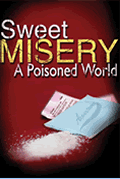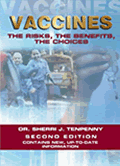Other
Ryter
Articles:
The Two Kerry's:
War Hero or
Traitor?
"Men in Black" The Cult of The Judges
BIRD
FLU OR WEAPONS GRADE FLU?
By Jon Christian Ryter
February 22, 2006
NewsWithViews.com
In 1996 a highly pathogenic virus known as H5N1 was isolated in a farmed goose in Guangdong Province, China just outside Hong Kong. A year later, the first infectious transfer of H5N1 occurred at a Hong Kong poultry farm. Eighteen cases of humans infected with the avian H5N1 virus occurred. Six fatalities resulted. A month later two cases of transmitted H5N1 were reported from Hong Kong citizens who visited Fujian Province in China. One of the two infected people died. A third family member contracted a severe respiratory illness while the family was still in Fujian. She died before the family could return to Hong Kong. No tests were done by the Chinese government to determine if she was a victim of the strange, deadly avian virus.
On Dec. 19, 2003 pathogenic H5N1 was found on three Korean chicken farms. On Jan. 8, 2004 the first case of H5N1 was reported in Vietnam. Three days later cases of severe respiratory illness were reported in Vietnam. Cases continued to be reported through mid-March. At least one death was reported during that interval. On January 12, the first case of a person infected with H5N1 was reported in Japan. On Jan. 23, Thailand reported two confirmed cases of people infected with H5N1 The following day, Cambodia reported discovering H5N1 in chickens. On Jan. 27 Laos reported finding H5N1 in poultry. On Feb. 1, a family cluster of cases�which had actually occurred in January�in Vietnam led investigators there to believe they had human-to-human viral transfers. But they were not able to confirm that human-to-human transmission had actually transpired. Later that same month, H5N1 was reported in Indonesia.
On July 8, 2004 research scientists discovered a dormant Z genotype in poultry and concluded that H5N1 had mutated just enough to find a new ecological niche in poultry, but that it had not yet fully adapted to its new host.
The fear levels through the epideminology community have been rising steadily since the first deaths from H5N1 were reported. Those fears were compounded by the manner�and speed�in which H5N1 is traveling around the world. On April 30, 2005 wild birds began dying at Qinghai Lake in central China where millions of migratory birds congregate every year. Altogether, 6,345 birds from several different species died there. China did not report the incident to the WHO until June 8, 2005�after the health organization learned about it from other sources.
WHO scientists isolated the virus found in the dead birds from Qinghai Lake and decided that the virus that killed them was a new H5N1 variant�and that the new strain was even more lethal to wild birds than the previous strains since the new strain was antibiotic resistant. That particular H5N1 variant, in fact, proved to be lethal to field mice as well. WHO scientists know that the avian viruses H5N1, H1N1 and H3N2, spread through the feces of birds as they travel the winter migratory routes around the world. Birds congregate at specific avian rest stops on their global sojourn and the transfer of H5N1 between avian species takes place at these "rest stops." The virus is passed from bird-to-bird and bird species-to-bird species through infected feces droppings.
In July 2005, a highly pathogenic form of H5N1 appeared in Russia, then Turkey, Romania and Croatia. In December, the first outbreak of H5N1 was reported in the Ukraine. Last week, cases of H5N1 were reported in Bulgaria, Austria, Germany, Greece, France and Italy. If the research scientists are correct and H5N1 is traveling the migratory bird routes, there is not going to be a nation in the world that is not affected since wild fowl congregate at common global way stations as they migrate around the world. This rapidity with which H5N1 is circumventing the globe gives rise for alarm�but not because there is a global pandemic flu outbreak in the making. H5N1 is not yet reached flu status even though it is an influenza virus. The odds of experiencing a "biblical catastrophe" of epic proportions is possible if H5N1 mutates into an airborne flu virus like the H1N1 virus that morphed into H3N2 and caused the Spanish flu pandemic of 1918-19.
So if H5N1 isn't an airborne influenza virus, why is WHO and the Centers for Disease Control [CDC] calling H5N1 "bird flu"? Scientists argue that the current H5N1 strain is close enough in appearance, microscopically, to the 1918 Spanish influenza strain to merit the global alert�and the fear mongering needed to make people obedient to the edicts of health officials in government when your liberties are curbed to prevent the spread of Chinese Flu (much more accurately named than calling H5N1 Bird Flu) should the virus morph into a full-fledged flu pandemic.
Spanish flu killed over 40 million people throughout the world. Six hundred thousand people in the United States died from the H3N2 virus. Spanish flu appeared to fester to life in the battlefields of Europe and quickly spread to the four corners of the Earth. Most of the dead�civilian and military�were from 20 to 40 years of age. It was almost as though Fate was determined to claim all of the war-aged people during the war-to-end-all-wars.
Researchers comparing the original H1N1 avian genome with the mutated H3N2 Fort Riley strain that caused the Spanish flu pandemic of 1918-19 with the Chinese H5N1 strain, believe that while they are completely different strains of virus, they share some virulent characteristics. Dr. Donald Burke, MD at Johns Hopkins University said the "viral chatter" about similar traits suggest there may be something very sinister just around the corner. Based on what the scientific community would like us to believe is mere speculation, the CDC believes that H5N1 will mutate into an airborne influenza virus.
The CDC's supposition is based on two premises. First, it claims that H5N1 is almost a clone of the H3N2 Spanish flu virus that killed 40 million people. In point of fact, while the two viral strains share at least two similarities, they are completely different viruses. Both began as avian viruses that were transmitted by ingestion. And, both H3N2 and H5N1 appear to have mutated from an avian virus, H1N1. (The link between the two may be military scientists in search of the perfect biological weapon.)
Second, studies done by the CDC, the US Army's Institute of Pathology and Mt. Sinai School of Medicine maintain that all known influenza viruses originate from avian viral strains. A recent CDC report noted that the 1918 Spanish Flu (also known as "La Grippe") contaminated pigs through a mechanism known as genetic drift as the pigs ingested infected chicken droppings. The virus, which initially was transferred through ingestion of infected droppings, ultimately mutated into an airborne flu virus. For that reason, the CDC is convinced that, ultimately, the same thing will happen with H5N1.
How does the CDC know this? Because the US military created the first military strain of influenza. H1N1 morphed into H3N2. Spanish Flu was created at Fort Riley, Kansas in April, 1918 from the naturally-occurring avian virus, H1N1. The "made for public dissemination" PR release that came out of Fort Riley after a soldier contracted Swine Flu noted that a kitchen worker at the base contracted a form of influenza from handling unclean food in the mess hall. The Public Affairs officer noted there was no threat to the general public since the mess at Fort Riley raised its own chickens and pigs. The infected poultry, the press release noted, had been destroyed. What the press release did not make clear was the fact that the virus that infected the soldier was a mutation of the naturally occurring avian virus, H1N1 called H3N2.
On June 4, 1918, H3N2 appears to have gone to war with the doughboys of the 2nd Division of the American Expeditionary Force�although as many American, French and British soldiers as German soldiers would become its victims on the battlefield at Chateau-Thierry. As the Germans used mustard gas against the Allies, it appears the Allies indiscriminately used H3N2 against the Germans. Once it was unleashed, H3N2 needed no help to become pandemic. The first military dead attributed to H3N2 were recorded by the US military on July 13, 1918. Initially those infected by the H3N2 influenza got sick, but there were few fatalities. By late summer the virus morphed into a more severe form. This second wave spread quickly along the Western Front.
Over 70 thousand Allied troops�many of them American�were stricken and hospitalized. Nearly one-third of them died. About one fifth of the soldiers from the trenches of France developed bronchial pneumonia or septicemia blood poisoning. Others developed heliotrope cyanosis. Over 95% of those who developed heliotrope cyanosis died within a few days. The news that a pandemic influenza was disseminating the battlefields of Europe, and that H3N2 was killing more soldiers than the cannons of war, was first reported by the Spanish media, which named the virus "the French Flu," since the first victims came from the battlefields along the Marne River. The American media renamed the virus the Spanish Flu, claiming they did so only because the first deaths to the deadly influenza were reported in Spain in May, 1918. The media report was untrue. While Spain was the first nation to report the existence of the influenza, the plague did not hit Spain until it became pandemic and struck all of the nations of Europe as it traveled the trade routes and sea lanes from nation to nation.
The most interesting thing about the Fort Riley strain of influenza is that it resurfaced at Fort Dix, New Jersey on Feb. 5, 1976. Only what showed up in the autopsy of its first victim in 58 years was a modified version of the original viral strain�HSW1N1� which mutated from the H1N1 strain that was initially isolated at Fort Riley. An Army recruit, Pvt. David Lewis, told his drill sergeant at Fort Dix that he felt tired and weak. He declined a chance to go on sick call. Instead, he participated in a training hike. The next day he was dead. The military press release noted that Lewis died from something called "swine flu." Four other recruits fell ill to swine flu and were hospitalized. Government doctors who hastily tested all of the soldiers at Fort Dix learned that over 500 of them were infected with swine flu�yet none of them showed symptoms. They would have been "carriers." Had those soldiers not been tested and isolated, a swine flu epidemic would likely have erupted in New Jersey. Interestingly, when the Fort Dix strain of influenza surfaced so did the military's Fort Riley solution�a vaccine created to treat the original H1N1 strain before it did its genetic drift and mutated into H3N2. The research scientists at Fort Riley created a vaccine to go with the influenza they created in a test tube.
According to a recent CNN report, the Chinese�fearing an outbreak of a new pandemic flu�admitted that they experimented by inoculating farm fowl against avian flu with human antiviral vaccines . The UN Food and Agriculture Organization [UNFAO] confirmed that, in a series of experiments, Chinese veterinarians began inoculating chickens with the human antiviral vaccine, Amantadine. The government of the People's Republic of China�through its embassy in Washington, DC�denied using Amantadine on poultry since logic suggested that using human vaccines on poultry would be an experiment with disaster since it would likely not only not work, it would make the virus immune to that antibiotic. Which is precisely what happened. The unanswered question is: was the Chinese experiment an accident, or a scheme to unleash a super influenza virus on the world that went awry when the virus escaped?
When Dr. Anthony Fauci from the National Institute of Allergy and Infections Diseases at the National Institutes of Health isolated the H5N1 virus in an attempt to create an effective vaccine, his group tested H5N1's sensitivity to Amantadine. H5N1 was resistant to Amantadine�and every other known influenza vaccine. The only currently available drug that works against H5N1 appears to be TamiFlu. But, TamiFlu in very limited supply�and, unlike Amantadine, is very expensive. Instead of eradicating H5N1, the Chinese created a super virus that is more resistant to antiviral vaccines than any influenza known to man. TamiFlu, the fall-back-on universal flu antibiotic appears to be the only answer to the super influenza bug that is now circumventing the globe along the migratory bird routes.
The UN claims China began experimenting with the avian influenza virus not to create a weapons-grade super bug but simply from fear. China feigns ignorance by claiming it is one of the most "at risk" nations in the world for an avian influenza pandemic because its soil has the second greatest deficiency of selenium in the world. According to the Chinese, the soil of over 40 nations or regions are sorely lacking in selenium, including most of Europe, the United States and Canada, and most of Southeast Asia�including all of China. China and India purportedly have the least amount of selenium in the soil and are, therefore, most at risk should another pandemic occur, since foraging birds must have selenium in their diet or risk falling prey to the avian influenza viruses.
However, most of the problem with the rise of H5N1 initially came not from foraging wild birds, but from controlled poultry farms in Guangdong Province just outside Hong Kong. The food sources of domestic farm poultry are regulated by poultry farmers. As such, it would seem that selenium would be an additive in the grains feed to the stock in the poultry farms.
|
Subscribe to the NewsWithViews Daily News Alerts! |
Today, 90 people worldwide have succumbed to H5N1. Over 400 people have become infected with the virus. To date there have been no proven incidents of people-to-people transfers of the virus. When that happens, H5N1 will transition from a virus that infects by ingestion to an airborne virus that will be properly called Chinese Flu. It will become the most lethal influenza pandemic in the history of mankind. It will, in fact, become one of those types of plagues that Bible prophecies talk about.
� 2006 Jon C. Ryter - All Rights
Reserved
Order Jon Ryter's book "Whatever Happened to America?"
Sign Up For Free E-Mail Alerts
E-Mails
are used strictly for NWVs alerts, not for sale
Jon Christian Ryter is the pseudonym of a former newspaper reporter with the Parkersburg, WV Sentinel. He authored a syndicated newspaper column, Answers From The Bible, from the mid-1970s until 1985. Answers From The Bible was read weekly in many suburban markets in the United States.
Today, Jon is an advertising executive with the Washington Times. His website, www.jonchristianryter.com has helped him establish a network of mid-to senior-level Washington insiders who now provide him with a steady stream of material for use both in his books and in the investigative reports that are found on his website.
E-Mail: BAFFauthor@aol.com
When that happens, H5N1 will transition from a virus that infects by ingestion to an airborne virus that will be properly called Chinese Flu. It will become the most lethal influenza pandemic in the history of mankind. It will, in fact, become one of those types of plagues that Bible prophecies talk about.













